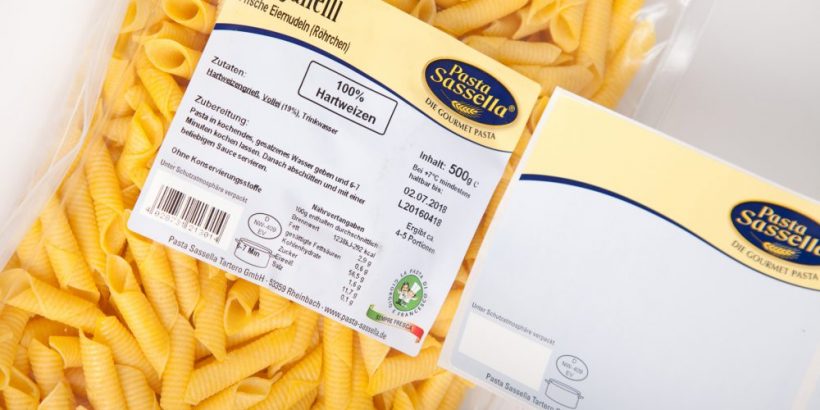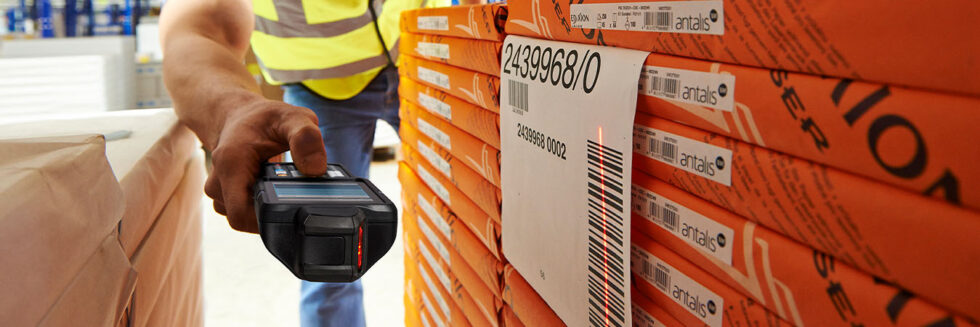Food Labels – How to Print and Apply
As consumers, we are dependent on a wide range of information being displayed on food:
- What is the name of the product?
- What ingredients and nutrients does it contain?
- What is the shelf life of the product?
- Where was the product made?
We rely on the information on the packaging to be correct, accurate and understandable. Product labeling is therefore an extremely important issue in the food industry. Without it, the food industry would not be able to put its products on the market in the first place. Labels are very important here. Below you can read why.
Food labeling – why is it so important?
There are different types of food labeling. One possibility is the marking with labels.
Self-adhesive labels in the food sector are mainly used for decorative reasons. The appearance of the labels serves primarily to promote the sale of the respective food. The labels often show appetizing serving suggestions, recipe suggestions, health aspects and more. Since it is supposed to be an absolute eye-catcher, the demands on the appearance of the label are enormously high; especially with regard to print quality.
However, the label is not only an eye-catcher in the food industry that creates incentives to buy. It is the most important information carrier of all because it fulfils the following functions.
Consumer information
Food labeling serves to protect consumers and creates confidence. Food is labeled with information on ingredients, properties of the food, additives, allergens, genetically modified organisms, energy, sugar, fat, salt, best before date and origin. Consumers appreciate transparent labelling and are often prepared to spend more money on a high-quality product.
All food manufacturers are obliged to display certain information on the packaging in a clearly legible form. The marking can be made directly on the packaging or by using a label. Uniform standards apply in all member states of the European Union.
Traceability
The label as a marking carrier on a product ensures traceability. The consumer has the opportunity to trace a food product through all stages of production, processing and distribution.

For the identification of the food the so-called batch marking is available. This is an indication which is noted on the sales units of food products which have been produced under the same conditions. This number consists of numbers or letters or a combination of both and usually begins with an “L”. For the food producer, the lot number allows him to identify directly the production batch. This is extremely important, for example, in the event of a necessary product recall.
Marketing and advertising

The label on a food product is not just a data carrier. It also serves as an advertising medium. It gives the product its unmistakable appearance and arouses sympathy and buying incentives in the customer. The label gives the product its appearance and ensures the recognition effect. Promotional offers such as winning codes can also be found on it.
Brand and product protection
Brand and product protection guarantees the distinctiveness of goods. The name and motto of a product are its unmistakable characteristics and make a product a brand. To protect these, labels offer the possibility to protect the product from copying and product piracy and to make it unmistakable. This serves not only the brand owner, but of course also the consumer.

Individually developed labels with special properties such as holograms, ink tipping effects, broken label materials, sealing labels or hidden contents in the labels (e.g. built-in threads or special colors) make it virtually impossible to counterfeit a product label.
First opening and manipulation protection
To increase consumer and product protection, there are labels with first-opening protection. They indicate when a product has already been opened. Labels are a very reliable solution here, as unmistakable contents can be incorporated.

This can be achieved, for example, with seals in special shapes or labels with special perforations that tear when opened. Closure seal labels made of a special material that cannot be removed from the product in one piece, but breaks into many small components, also offer reliable protection against manipulation. So-called void labels leave an unmistakable mark on the product when they are removed. Re-gluing is impossible.
What information must food packaging contain?
Labeling on food regarding ingredients, origin and properties protects the consumer and is required by EU law. This is an obligatory labeling. The following information must be included on the labels:
- Sales description: The product must be described clearly and objectively so that everyone understands what food it is
- List of ingredients: Information on ingredients contained in the product must be listed in descending order of their weight percentage. The 14 most relevant allergens are always marked in the list of ingredients.
- Filling quantity: The contained quantity of the product is to be indicated by number of pieces, weight in grams or kilograms or, in the case of liquids, in milliliters or liters.
- Best before date: How long does the product retain its desired quality, possibly under certain storage conditions? On certain products (e.g. raw meat), a use-by date must be indicated, after which the food is no longer fit for consumption.
- Name and address of the manufacturer, packer or seller must be visible.
- Lot number: This number allows you to trace back when and in which lot the product was produced, manufactured and packaged.
- Nutritional labelling: All legally required nutritional information must be listed in tabular form.
- Price indication: The final price of the foodstuff must be indicated on the packaging or near the goods (e.g. on the shelf). For all foods sold by weight or volume, also the basic price (price per 100 g/ml or per 1 kg/l).
Manufacturers can also use optional markings. These are additional indications that offer added value to the customer. A current example is the extended nutritional value labeling through the Nutri Score. However, organic seals and other labels or the CO2 footprint are also included.
How to find the right food labels
In the case of food labelling, it is imperative to ensure that all food law regulations are observed. These apply to the labelling of the material components used:
- What is the nature of the outer material, what are the ingredients of the adhesive?
- Can these material components penetrate through the packaging and change the contents if necessary?
- What should be taken into account when selecting labels for direct food labelling?
- Welche Etikettenarten können für die indirekte Lebensmittelkennzeichnung verwendet werden?
The individual requirements must be precisely defined with the food manufacturers. Therefore it is important to know some information about food production and packaging type before choosing the label:
- What is the packaging like?
- Can ingredients of the adhesive diffuse?
- When does which production step take place?
- When should the label be applied?
- What are the environmental conditions: temperatures? deep-freezing? humidity? Fat resistance?
- Direct or indirect marking
- Examples of direct food labelling: directly on fruit, vegetables, bakery products, meat and sausage products, cheese
- Examples of indirect food labeling: on glass, plastic, foil or paper packaging, cans
These requirements can already be met with cost-effective blank labels, among other things. If the food labelling should only contain a barcode and other monochrome elements, this can be printed very easily in your own company with blank labels, a label printer and the right Legitronic label printing software or with the label software from Nicelabel.

Decorative labels or pre-printed labels, which give the product its unmistakable appearance, can be produced in our label production freely according to customer requirements. The possibilities are almost unlimited: individual shapes, sizes and imprints give food products an impressive label.

Of course it is also possible to print colored labels yourself. High-performance color printers are available for this purpose. This is particularly useful when producing different types and quantities of products that require different product labels.
Alternatives to the label
Depending on the production environment, high demands are placed on the marking technology. For example, dust and moisture can be a challenge for the food manufacturer, in addition to compliance with legal requirements. But the type of labeling is also decisive: Did you know which interesting solutions are possible for food-safe labeling?
Basically, the following marking systems are available for selection:
- Ink jet printer
- Labeling systems
- Thermal transfer direct printer
HP AutoID Solution Systems : Your partner for food labeling!
The selection of the appropriate solution requires a lot of expertise. As a full-range supplier for industrial marking, we can provide comprehensive advice on the right technology and the ideal labels for your application. Just contact us!
Contact HP AutoID Solution immediately to get more information and preferential policies
#431 street 230, Sangkat Teok Laork 3, Khan Toul Kork, Phnom Penh, Cambodia
Tel : +855 99983734 (Mr.Hour)
Email: Info@hpsolutinons.com.kh
Website: Hpsolutions.com.kh


 VN
VN
 EN
EN




